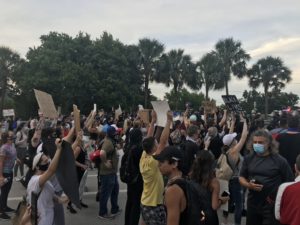By Abby Hobbs
The murder of George Floyd on May 25 in Minneapolis by police instigated the Black Lives Matter movement that grew to incredible lengths in a short amount of time. More than 70 days later, BLM protests are still occurring around the world, and locally, students are doing what they can to help out.
Rachel Rose, senior at American Heritage School Boca/Delray, has been working closely with the school’s faculty to raise accountability and awareness on campus as president of the Black Student Union club.
“Too many times you hear that a black person or another person of color was called a racial slur and the [organization] didn’t take action,” Rose said. “It’s not enough for schools and companies to say that they support the BLM movement and racial equality, they need to act on it.”
Avah Reed, senior at Boca High School, agrees.
“When institutions simply state that they stand with black lives on their social media page, it is contradictory to their actions of utilizing prison labor in their production and donating funds towards Donald Trump,” Reed said. “A prime example of a company who supports BLM is Ben and Jerry’s, who donate funds, consistently spread information, and pay their staff livable wages.”
Reed is trying to influence her community by attending protests in her area, spreading information through social media, signing protests, and donating to bail funds.
According to Reed, some of the most important things to do to promote change right now is some of the most difficult.
“Having those uncomfortable conversations with family and friends who are ignorant of the current state of danger [people of color] are in. This is something that I am personally struggling with and trying to work on since I’m not a very confrontational person, but it is one of the most vital things to do to bring in perspective and encourage support towards the BLM movement,” Reed said

Abia Rahman, junior at American Heritage Boca/Delray, says media portrayal has greatly contributed to the political divide over the movement.
“The media was covering the protests negatively because they focused on the looting that a small fraction of protestors took part in instead of recognizing the peaceful protests, and then decreased in coverage because the looting has almost completely stopped so the only thing that the media can show is the peaceful protests and that’s not as ‘interesting.’” Rahman said.
Reed also acknowledges the change in coverage over the protests from early June to late July.
“News outlets tend to display protests as a form of anarchism and radicalized people, especially right wing news outlets. I think the media rapidly decreased coverage on protests because people see this movement as a trend and a moment of rebellion against racism, when in reality it is a long term issue that people are continuing to tackle,” Reed said.
Another issue students are facing with the BLM movement is performative activism on social media.
Rose said, “It’s better to openly state your opinion than to submissively follow a trend. I find it worse when people contribute to performative activism than when they openly express dissent.”
An example of performative activism in the BLM movement recently was for Blackout Tuesday, which originated from the idea of abstaining from releasing new music and content on June 2 to show solidarity to the movement, but ended up as a social media trend of posting a single black square.
“Blackout Tuesday also should have been a day to amplify black voices and dedicate a day towards spreading vital information instead of usual beach pictures, rather than clogging social media feeds with black boxes,” Reed said.
The most important thing students can do to contribute to the Black Lives Matter movement is voting, according to Reed.
Reed said, “we need to elect leaders that will support the cause and create change within the system.”
